The Monstera Adansonii White Variegated is a stunning and unique houseplant that has captured the hearts of plant enthusiasts worldwide. Known for its striking white variegation and fenestrated leaves, this plant adds a touch of exotic beauty to any indoor space. In this guide, we will explore how to care for and propagate the Monstera Adansonii White Variegated.
Introduction
The Monstera Adansonii White Variegated is a member of the aroid plant family, which includes popular varieties like Philodendron, Anthurium, and Aglaonema. Native to the tropical regions of Central and South America, this plant is prized for its unique, white-variegated leaves. Similar to Syngonium and Epipremnum, the Monstera Adansonii White Variegated is not only beautiful but also relatively easy to care for.
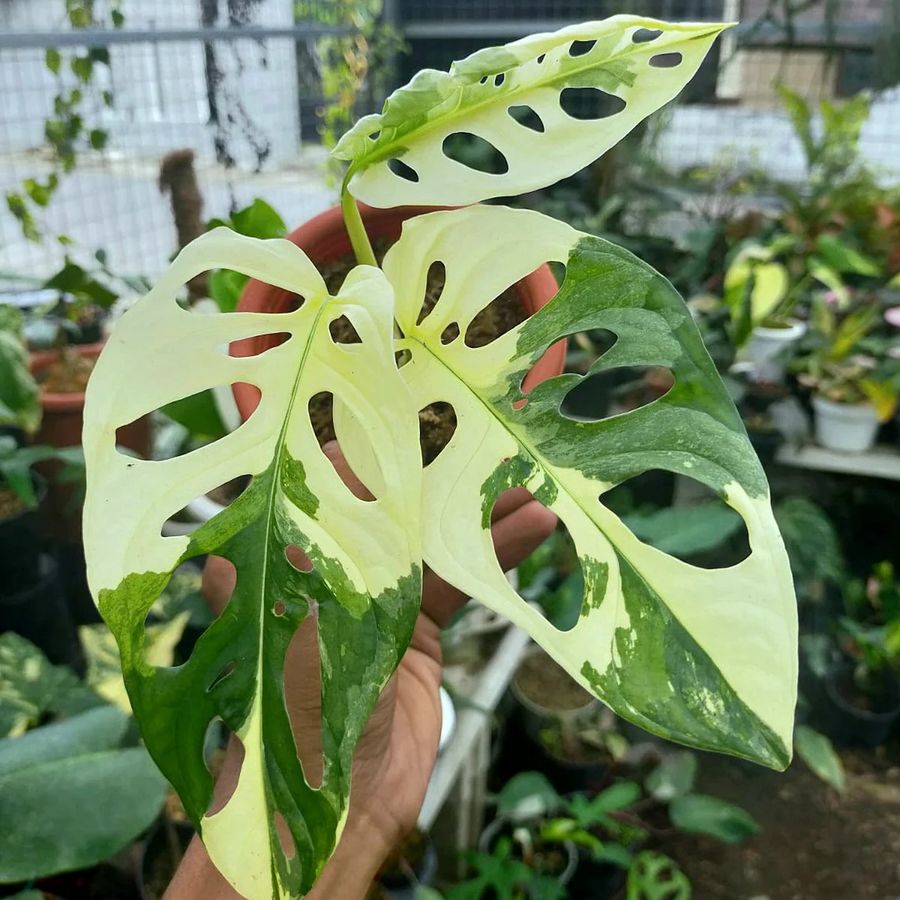
Growth Habits and Origin
The Monstera Adansonii originates from the tropical rainforests of Central and South America. In the wild, this vine climbs up tree trunks and branches using its aerial roots to reach the forest canopy where it receives dappled sunlight. It provides information about the origin of the Monstera Adansonii, which is a type of Monstera plant.
Natural Habitat
- Native to the tropical forests of Central and South America
- Naturally found climbing up trees and canopy
- Thrives in warm, humid environments with indirect bright light
Features
- Evergreen vine growing 6-10 feet long
- Oval leaves with holes and splits, known as “fenestrations”
- New leaves emerge green with white variegated patches
- Produces white flowers and edible fruit (rarely indoors)
Popular Houseplant Varieties
There are a few popular Monstera Adansonii houseplant varieties:
- Monstera Adansonii – All green leaves
- Aurea Variegated – Aurea splashes on green leaves
- Albo Variegated – Predominantly white leaves
The white variegated variety features gorgeous green and white mottled leaves. The level of variegation can vary widely between plants.
Growing Conditions
Caring for a Monstera Adansonii White Variegated houseplant mainly involves providing the right amounts of light, water, humidity, and optimal temperatures, as it discusses specific care requirements for the Monstera Adansonii, a topic comprehensively covered in the care guide.
Light
- Thrives in bright, indirect light
- Locate 3-5 feet from a south or west facing window
- Direct sunlight will scorch the leaves
Variegated Monsteras need bright, indirect light to maintain the white coloration on the leaves. Insufficient light leads to reversion where leaves emerge all green. Place this vine a few feet away from a sunny window. An eastern exposure works but south or west is ideal. Filter sunlight with a sheer curtain to prevent leaf burn.
Water and Humidity
- Allow soil to partially dry between waterings
- Increase humidity to 50% or more
- Yellowing leaves indicate overwatering
Water a Monstera Adansonii whenever the top few inches of soil become dry. As a tropical plant, it also appreciates higher humidity around 50% or more. Increase humidity by misting the plant daily or using a pebble tray filled with water. Allow excess moisture to drain freely from the pot to prevent root rot.
Temperature
- Prefers average room temperatures 65-80°F
- Avoid cold drafts below 50°F
The Monstera Adansonii White Variegated thrives in average household temperatures between 65-80°F. Avoid placing this tropical plant near cold drafty windows in the winter which can damage the foliage.
Fertilizer
- Use a balanced liquid fertilizer monthly in spring and summer
- Reduce feeding in fall and winter months
Feed monthly with a diluted balanced houseplant fertilizer during the active growing season from spring through summer. Discontinue fertilizing over the cooler fall and winter months when growth slows.

“Unleash the beauty of nature in your home with the exquisite Monstera Adansonii White Variegated! Click here to bring this stunning plant into your life today.”
Monstera species are the most sought after by aroid plant lovers
Potting and Repotting
Choose a potting mix made for aroids and use a container with bottom drainage holes. Repot when severely rootbound into a slightly larger pot.
Potting Mix
- Well-draining aroid mix
- Ingredient blend of peat moss, perlite, bark
- Allows oxygen flow to the roots
The best potting mix for Monsteras is a soil blend specifically made for aroids like Monstera, Philodendron, and Anthurium. The ingredients typically include peat moss, perlite, orchid bark and charcoal. This airy, free-draining mix prevents soggy soil.
Pot and Drainage
- Plant in pot with drainage holes
- Plastic, ceramic, or terracotta pots
- Include drainage layer of pebbles or charcoal
Always choose a container with bottom drainage holes when potting a Monstera Adansonii. Plastic, glazed ceramic, or terracotta pots all work well. For extra drainage, add a 1″ layer of pebbles or charcoal chips at the bottom of the planter before filling with soil.
When to Repot
- Repot every 2-3 years in spring
- Size up 1-2″ inches bigger than previous pot
- Divide overcrowded plants
Check if your Monstera needs repotting every couple years in the spring. Indicators include roots growing out the drainage holes and lower leaf yellowing. Move up just one or two pot sizes at a time to prevent stress. Also divide severely rootbound plants.
Propagation
The quickest and easiest way to propagate a Monstera Adansonii White Variegated is through stem cuttings in water or moss. Root the cuttings before potting up.
Water Propagation
- Take 5-6 inch stem tip cuttings
- Remove lower leaves and place in water
- Roots emerge in 4-6 weeks
Cut stem tip segments below a node and remove the lower set of leaves. Place the Monstera cuttings in a jar of clean water. Roots and plantlets form at the nodes over the next month or so. Once roots reach 2-3 inches long, pot up the propagated plants.
Moss Propagation
- Take 3-4 inch stem cuttings
- Dip in rooting hormone powder (optional)
- Place end into sphagnum moss
Another propagation method uses a sphagnum moss medium instead of water. Remove lower leaves, dip the cut end in rooting powder if desired, and stick into the damp moss. Enclose in a plastic bag and check periodically for new growth.
Division of Mature Plants
- Divide when overcrowded every few years
- Gently tease apart rootball with hands or knife
- Pot separated sections individually
Mature and overgrown Monstera Adansonii plants can be divided by carefully dividing up the root system. Using your hands or a sharp knife, gently break up and separate out offshoots with roots attached into individual plants.
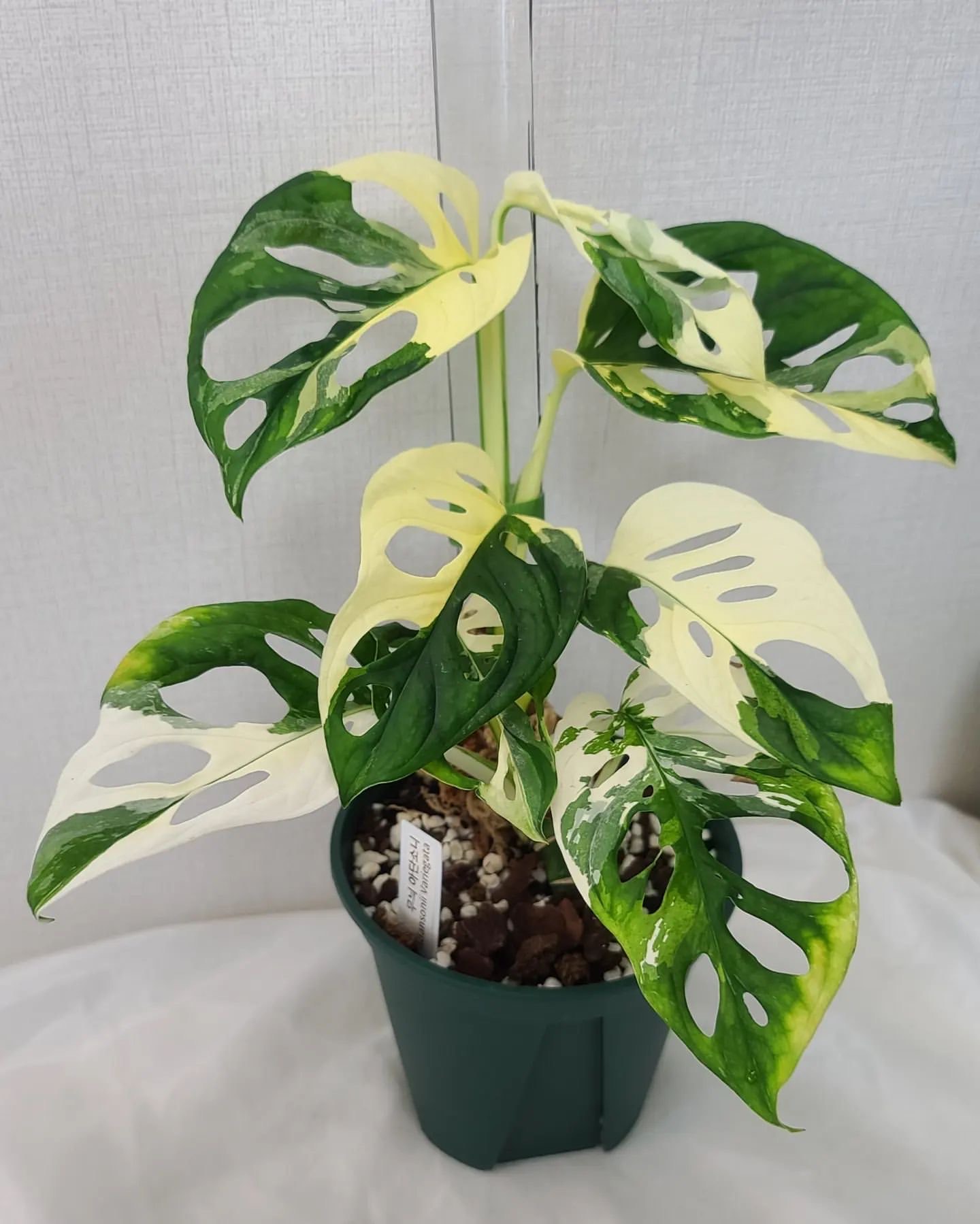
Troubleshooting Common Issues
Understand some potential problems in order to keep your Monstera Adansonii White Variegated happy and healthy. Monitor for pests, treat diseases, and avoid issues through proper care.
Leaf Spotting and Discoloration
- Overwatering causes yellow/black spots
- Low humidity leads to brown crispy tips
- Insufficient light makes leaves all green
Two common reasons for unusual spotting or markings on the foliage include inconsistent watering and low relative humidity. Keep the soil evenly moist without saturation and mist frequently. Also provide bright indirect sunlight.
Dropping Leaves
- Older leaves naturally yellow and drop
- Rapid leaf loss indicates underwatering
- Stem rot from overwatering
As a natural process, older leaves will eventually turn yellow or brown and drop off. However, rapid widespread leaf loss means the plant is likely getting too little water. On the other hand, overwatering causes stem and root rot.
Pests: Mealybugs and Scale
- Insect pests leave white deposits on plants
- Wipe leaves with alcohol/neem oil solution
- Apply horticultural oils or insecticidal soap
Check frequently for small white cottony pests like mealybugs and scale insects. These sap-sucking bugs leave sticky honeydew and can spread disease. Control minor infestations by wiping with isopropyl alcohol or using organic insecticides.
FAQs
Get answers to some commonly asked questions about growing Monstera Adansonii White Variegated.
Is the Monstera Adansonii White Variegated rare?
Yes, the white variegated form is quite rare and harder to find than the ordinary solid green variety. The level of white patterns on the leaves varies a lot between different plants. Pure white “albo” specimens with little or no green are the most prized.
How do you maintain variegation?
Getting bright indirect sunlight is crucial for keeping the white parts of the variegated Monstera Adansonii leaves vibrant. Insufficient light causes reversion to solid green growth. Also allow soil to partially dry out between waterings and feed monthly during spring through fall.
Why are my Monstera’s leaves drooping?
Drooping leaves are most often from underwatering. Feel the soil and water whenever the top few inches become dry. If moisture isn’t the issue, the plant could also be getting too little light or suffering from root rot disease. Address any cultural issues to perk up the leaves.
What temperature is too cold for a Monstera plant?
Avoid exposing the Monstera Adansonii White Variegated to temperatures below 50° F which can damage the tropical foliage. Move plants away from cold outdoor drafts and keep the indoor temperature comfortably around 65-80°F year-round.
How do I increase a Monstera’s humidity?
Boost moisture in the air around your Monstera by misting the plant daily with a spray bottle and placing the pot atop a water-filled pebble tray. Use a humidifier in the room during dry winter months to maintain 40-60% humidity. Group plants together to create a tropical environment.
Conclusion
With its iconic split and holed leaves accented in white, the Monstera Adansonii White Variegated makes a fabulous (and rare) houseplant specimen. Place this climbing aroid vine in a spot with bright indirect sun to encourage lush growth and vibrant variegation patterns. Provide the right amounts of water, humidity, and optimal temperatures as outlined above. Propagate new plants through stem cuttings. Address any issues promptly that arise and you’ll enjoy this gorgeous tropical for many years!

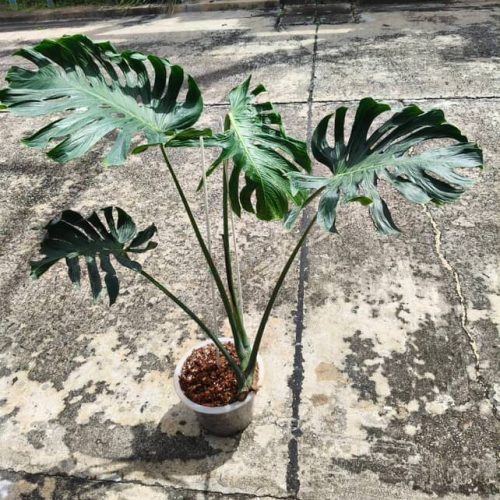
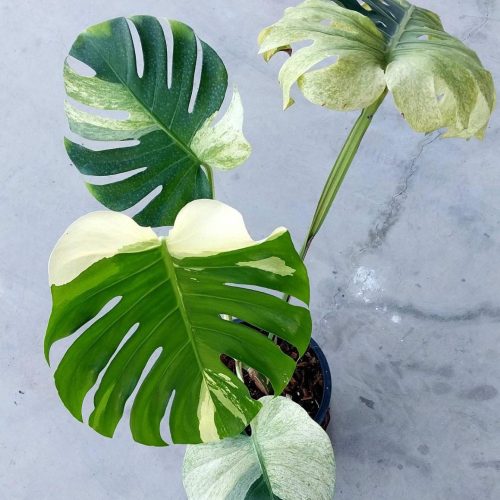



![12x Monstera Borsigiana Albo half leaves variegata [3-4 leaves]](https://greenboog.com/wp-content/uploads/2024/10/Monstera-Borsigiana-Albo-half-leaves-variegata-1-500x500.jpg)
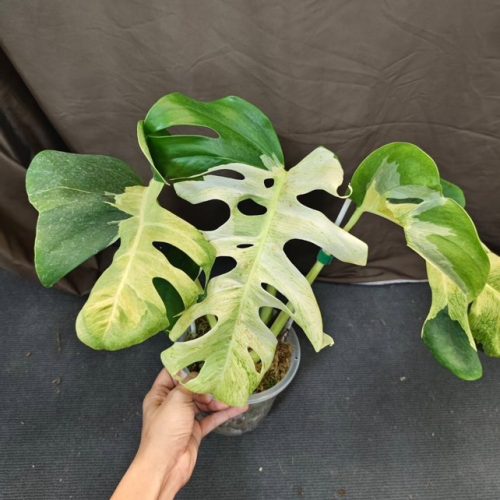

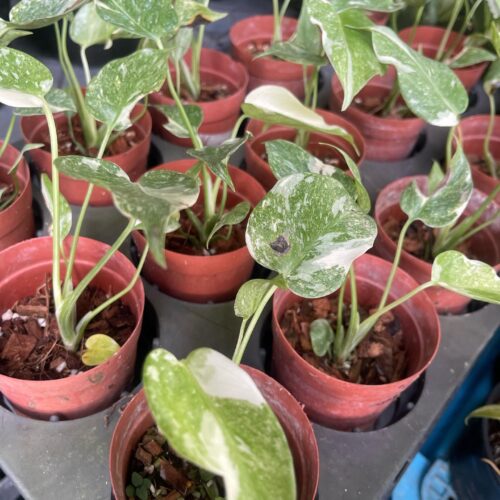
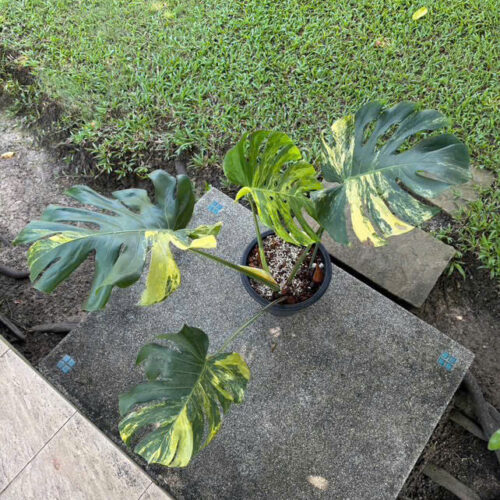
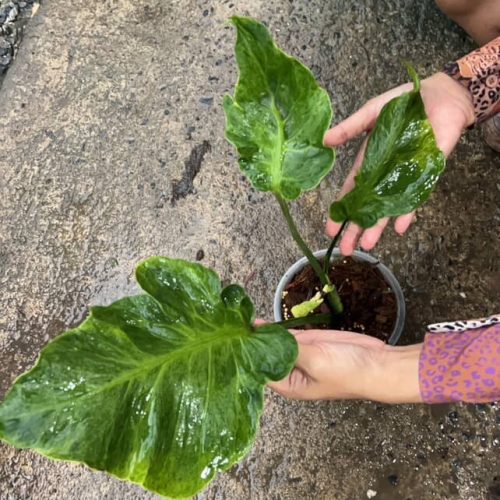
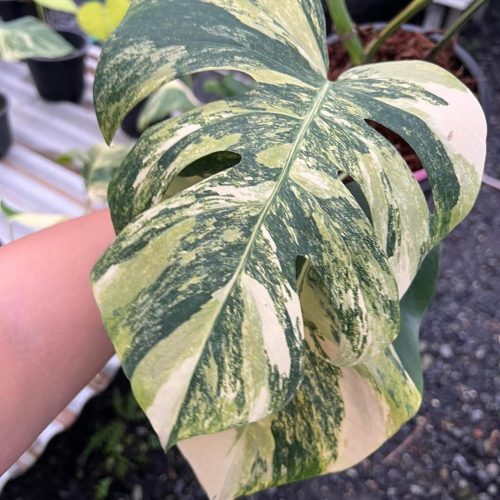

![10 Pots x Monstera Aurea Variegated / Mix Aurea tri color 3-4 leaves [well variegated]](https://greenboog.com/wp-content/uploads/2024/08/Monstera-Aurea-Tri-color-500x500.jpg)

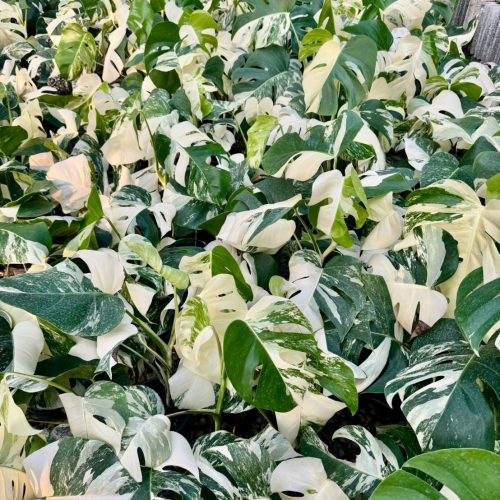
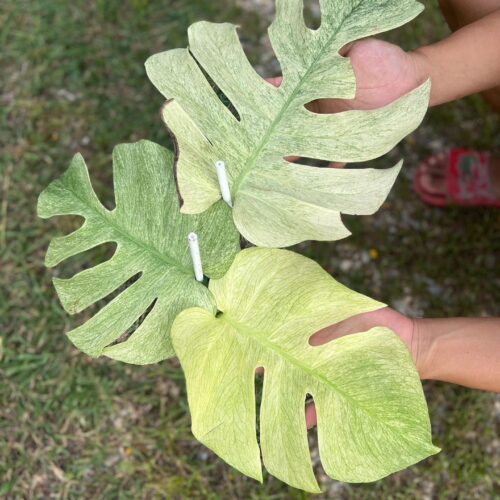
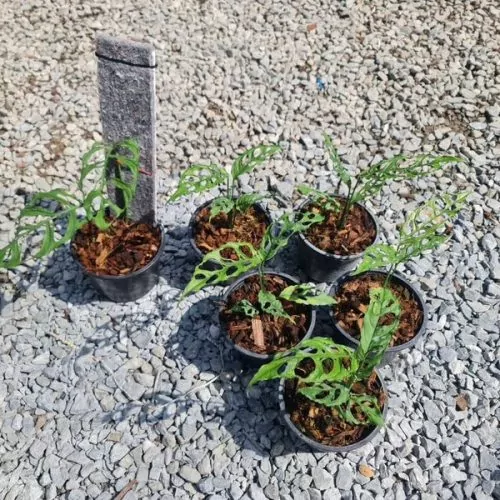
![[SALE] 10 Pots x Monstera Aurea Variegated 3-6 leaves [Medium size]](https://greenboog.com/wp-content/uploads/2025/01/Monstera-Aurea-variegated-4-6-leafs-500x482.jpg)

